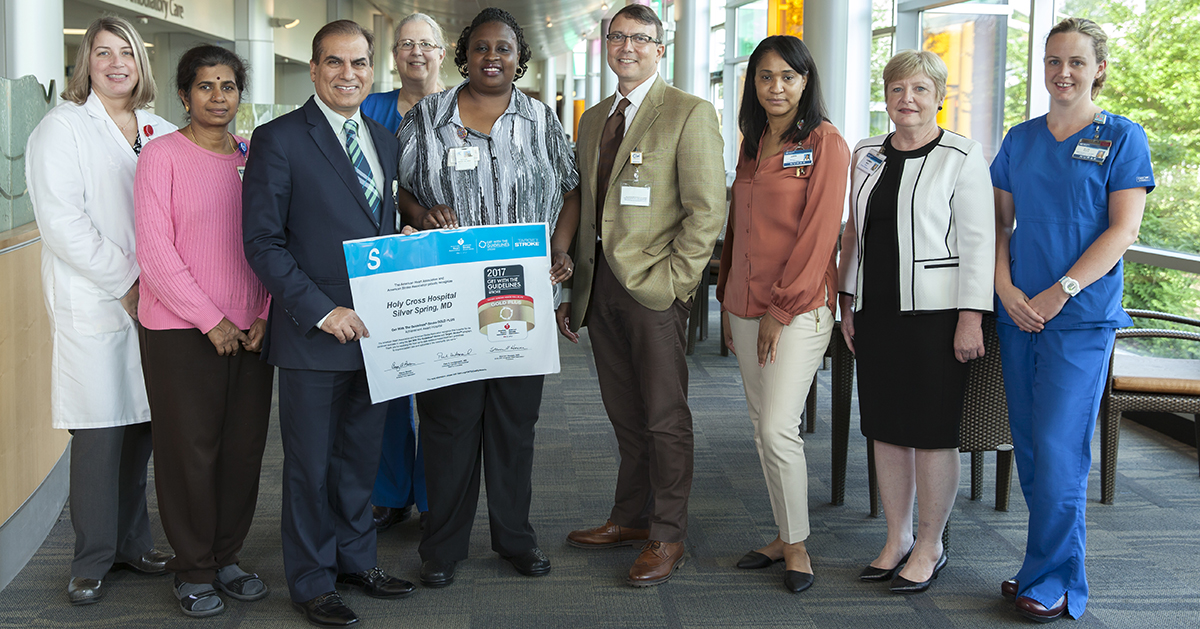American Heart Association 2017 Stroke Gold Plus Quality Achievement Award with Target: Stroke Honor Roll Elite
 Pictured are key members of the Holy Cross Hospital Stroke Team
Pictured are key members of the Holy Cross Hospital Stroke TeamSilver Spring, MD — Holy Cross Hospital has again been recognized for excellence in stroke treatment and its commitment to quality stroke care. This time the honor stems from a program created jointly by the American Heart Association and the American Stroke Association. The hospital is the latest recipient of the “Get With The Guidelines®-Stroke Gold Plus Quality Achievement Award with Target: StrokeSM Honor Roll Elite.” The award recognizes Holy Cross Hospital’s commitment to providing the most appropriate stroke treatment according to nationally recognized, research-based guidelines and the latest scientific evidence.
"High-quality care is Holy Cross Hospital's number one priority," said Lou Damiano, MD, acting president, Holy Cross Hospital. " This recognition from the American Heart Association/American Stroke Association reinforces our stroke team's commitment to the consistent delivery of life-saving, advanced stroke treatments for patients."
According to the American Heart Association/American Stroke Association, stroke is the number 5 cause of death and a leading cause of adult disability in the United States. On average, someone in the U.S. suffers a stroke every 40 seconds, someone dies of a stroke every four minutes, and nearly 800,000 people suffer a new or recurrent stroke each year.
Hospitals must achieve 85 percent or higher adherence to all Get With The Guidelines-Stroke achievement indicators for two or more consecutive 12-month periods and achieve 75 percent or higher compliance with five of eight Get With The Guidelines-Stroke Quality measures to receive the Gold Plus Quality Achievement Award. Holy Cross Hospital's Stroke Program has received this award each year since 2010.
To qualify for the Target: Stroke Honor Roll Elite, hospitals must meet quality measures developed to reduce the time between the patient’s arrival at the hospital and treatment with the clot-buster tissue plasminogen activator, or tPA, the only drug approved by the U.S. Food and Drug Administration to treat ischemic stroke. If given intravenously in the first three hours after the start of stroke symptoms, tPA has been shown to significantly reduce the effects of stroke and lessen the chance of permanent disability. Holy Cross Hospital earned the award by meeting specific quality achievement measures for the diagnosis and treatment of stroke patients at a set level for a designated period.
“The American Heart Association and American Stroke Association recognize Holy Cross Hospital for its commitment to stroke care,” said Paul Heidenreich, MD, MS, national chairman of the Get With The Guidelines Steering Committee and Professor of Medicine at Stanford University. “Research has shown there are benefits to patients who are treated at hospitals that have adopted the Get With The Guidelines program.”
Key Stroke Team Members
Key members of the Holy Cross Hospital stroke team pictured above include (from left-right): Julie Nenichka-Reed, MSN, MHA, RN, director, Neurosciences and Specialty Procedures, Holy Cross Health; Shashi Dudi, data abstractor, Performance Improvement/Outcomes Management, Holy Cross Health; Shahid Rafiq, MD, medical director, Neurology and Stroke, Holy Cross Hospital; Diane Marvinney, MSN, RN, clinical practice specialist, Emergency Center, Holy Cross Hospital; Sharon Harriston, RN, MS, CCNS, ACNP-BC, stroke nurse practitioner and coordinator, Stroke Program, Holy Cross Hospital; Zachary Levine, MD, FAAS, medical director, Neurosurgery, Holy Cross Health; Judith Boulay-Ganthier, RN, BSN, manager, Physician Performance Improvement/Outcomes Management, Holy Cross Health; Elizabeth Begley, director, Physician Performance Improvement/Outcomes Management, Holy Cross Health; Ellen Platte, RN, MSN, director, 6E Acute Care Unit/Neuro, Holy Cross Hospital.
Recognizing the Signs of a Stroke
It is important to recognize the signs and get immediate medical attention. Speedy stroke diagnosis and treatment can help dramatically improve recovery from strokes, including a TIA (transient ischemic attack) or mini-stroke.
The Five Major Warning Signs of Stroke are:
- Numbness, weakness or paralysis of the face, arm or leg, especially on one side of the body.
- Confusion or trouble speaking or understanding.
- Trouble seeing with one or both eyes.
- Trouble walking, dizziness, or loss of balance or coordination.
- Severe, sudden onset of headache with no known cause.
